Click in to the tabs below to read more about individual stories that involve historical convictions and charges of sex between men. There are eight stories available for you to read: Arthur; Harold; John and James; Francis and John; William and Robert; Gladstone; William and William; and Cosmo.
These stories were the direct result of the research undertaken within our fantastic history group between February to April 2021. Thanks go to the 15 volunteers who supported the project and research with over 137 hours of their time to recover the stories of these men.
Arthur was born in Martock in Somerset, and is recorded initially as the son of Sarah, a spinster. By the time of the next census, Arthur was still living in Martock with his family, but this time he is recorded as the son of Elizabeth, the head of the family and the mother of Sarah. Sarah does seem too young to have been Arthur’s mother, but the confusion here is interesting.
At the age of 19, Arthur was tried at the Old Bailey in London on a charge of gross indecency. Both Arthur and another man, William (aged 39) were found guilty. The judge sentenced William to 6 months’ hard labour, but ordered that Arthur enter into recognizances. This means that Arthur did not serve time in prison for this offence. The fact that both men were charged alongside each other appears strongly indicative of a consensual relationship, but the older man of the two received a harsher sentence seems to suggest that the judge saw him as more culpable than Arthur.
In the next census (1891), Arthur appears again in London and was working as a barman. By 1901, however, he had moved back to Martock, where he lived with his family and worked as an insurance agent. Shortly after this census return, Arthur was tried for ‘an offence’ with a man named Herman. Arthur gave evidence on his own behalf, but he was found guilty and sentenced to six weeks’ hard labour.
By 1911, Arthur was boarding in Wokingham, Berkshire and is recorded as working as an insurance agent. In 1913, he was indicted to the Berkshire Assizes on counts of gross indecency and attempting to procure the commission of gross indecency. He was found guilty and sentenced to nine months’ hard labour. None of those who were mentioned in the indictment alongside Arthur were indicted themselves. This may have been because Arthur was, by now, the older party.
The following year, Arthur was again indicted to the Berkshire Assizes on counts of gross indecency and indecent assault. Here, Arthur was tried before the Lord Chief Justice, and found not guilty. The other individual mentioned on Arthur’s indictment was not indicted himself. It is interesting that although Arthur had a number of previous convictions, he was found not guilty of this offence. The court was certainly aware of Arthur’s previous convictions for gross indecency but seem to have tried this individual case on its own merits.
In 1920, Arthur died in Taunton, having returned to Somerset where he was born.
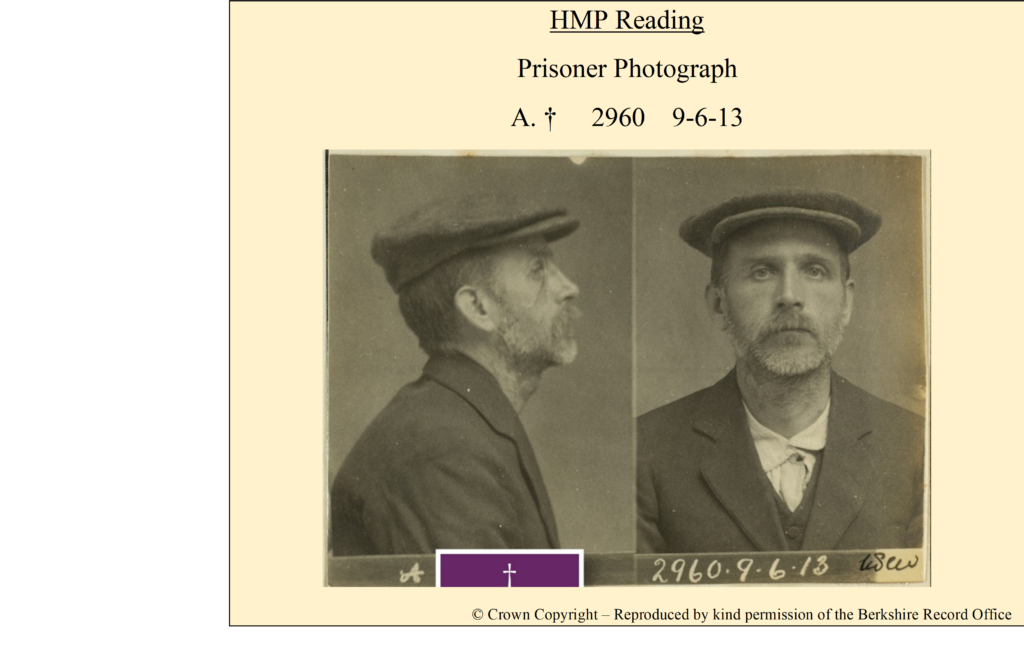
– Audio credit: Juliet England
Harold was born in the village of Chalfont St Peter in Buckingham, where he lived with his parents and siblings for 18 years before he appeared before Beaconsfield Petty Sessions (the equivalent of our Magistrates’ Court). This extract from the South Bucks Standard goes into more detail.

The hearing was also covered in the Uxbridge and West Drayton Gazette:

It appears that, although bail was allowed, Harold remained in prison until his trial at the Buckinghamshire Assizes, which was held before the Lord Chief Justice and covered in the Buckinghamshire Examiner.

The advocacy of Harold’s father on behalf of his son indicates that Harold remained on relatively good terms with his family even after he was accused of buggery.
Harold’s entry in the official ‘Calendar of Prisoners’ can be found in the Home Office files located at the National Archives in Kew:

It is interesting that Harold was tried using a charge of buggery, when the offence of gross indecency was much easier to prove. There are a number of reasons which could explain this, but the most likely seem to be that this was an offence that was deemed to be more serious by the court (possibly because of the circumstances of the sexual act) or because there was strong evidence that the sexual act alleged was that of anal sex rather than a more generalised ‘sexual activity’.
From the Buckinghamshire Assizes, Harold was taken to Reading Prison, and photographed for his prisoner mugshot.

After his prison sentence, Harold returns to Chalfont St Peter and played cricket for the village team, appearing in the newspapers again when he suffered a minor injury while driving a pony and cart. In 1918, he married a girl from Bristol and appears on the 1939 register as living in Gloucestershire. He was widowed after around 34 years of marriage and lived for another 12 years after that.
John and James lived close by to each other in Ruscombe, Berkshire. In 1885, they were charged alongside each other for buggery. At the time of their trial, James was 24, and John was 17. The fact that they were charged alongside each other strongly indicates that the sex was consensual, and it may also be indicative of the involvement of a third-party witness.
Their entry in the official ‘Calendar of Prisoners’ can be found in the Home Office files located at the National Archives in Kew:
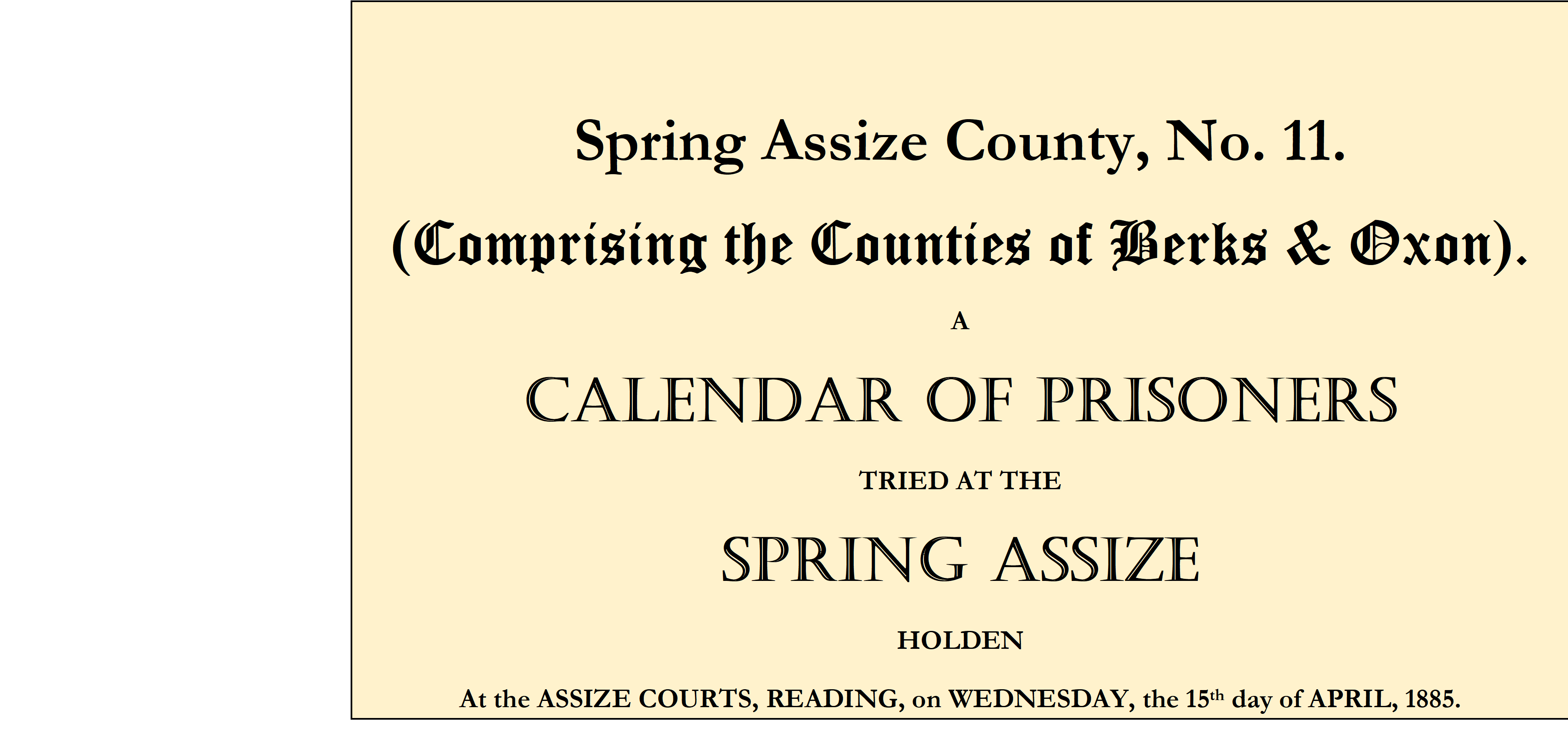
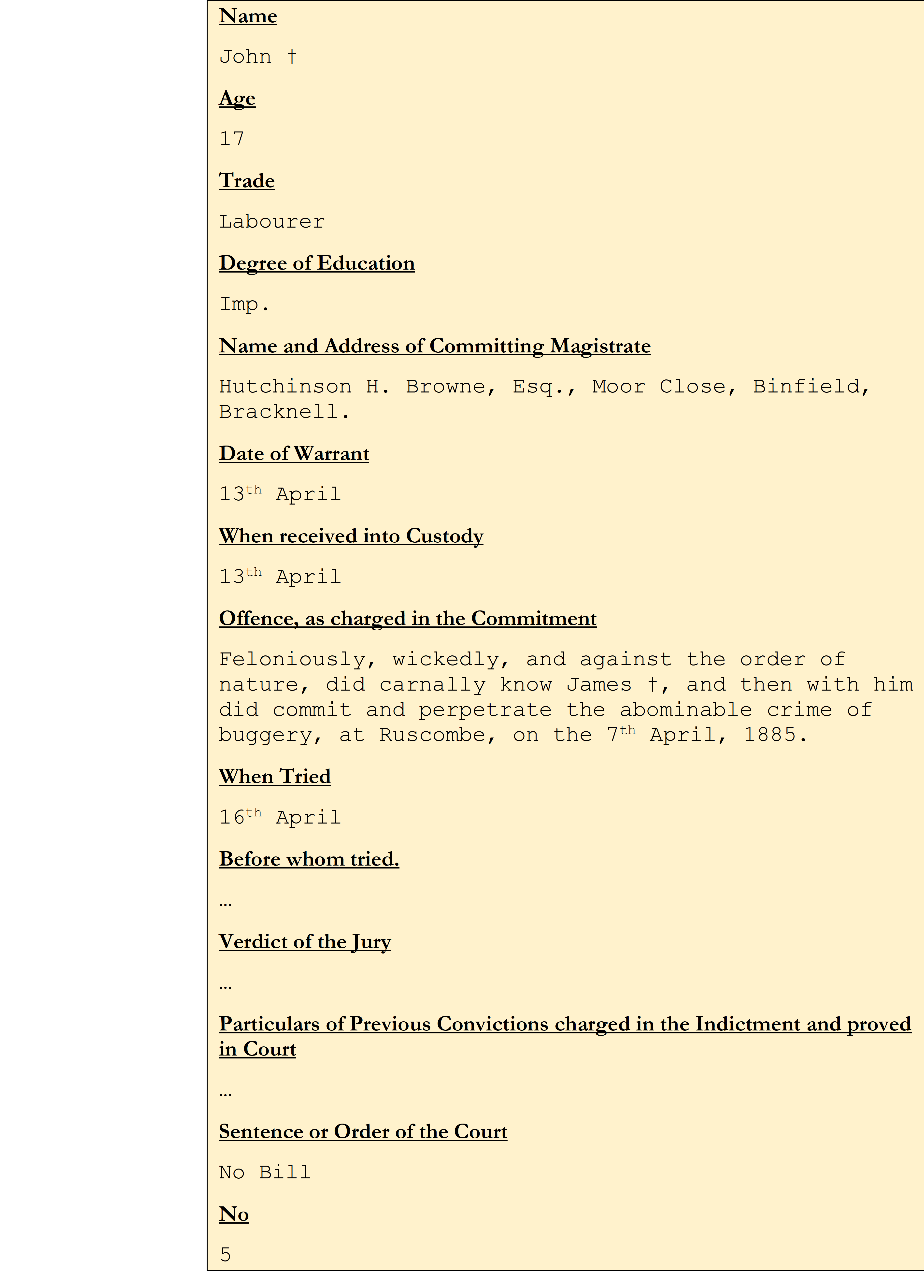
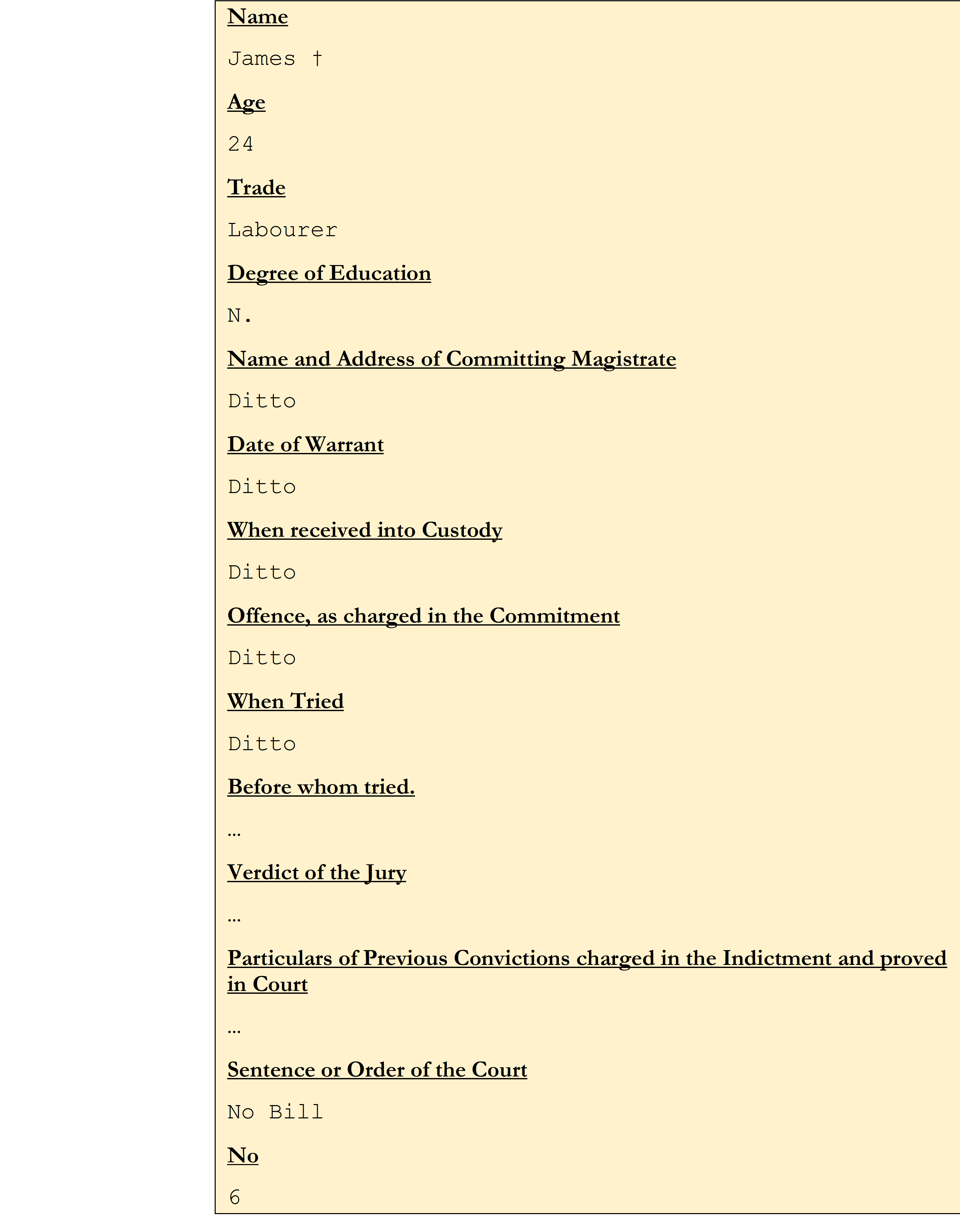
The trial was reported in the Oxfordshire Weekly News:
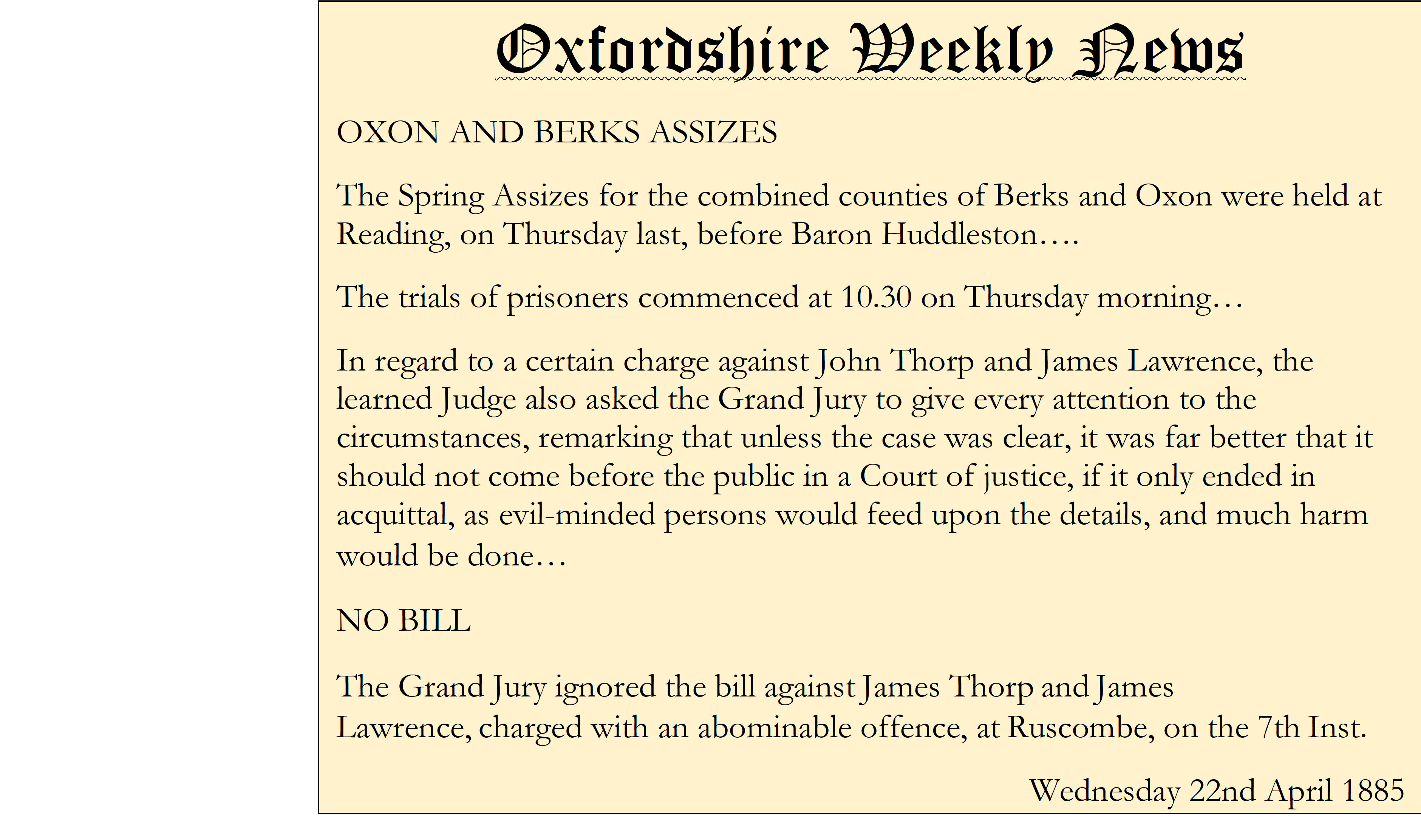
From this report, we can see that the judge was instrumental in having the case thrown out. Nineteenth century assizes courts had two juries. The first of which, the Grand Jury, decided whether the case should proceed to trial. The second, the Petty Jury, acted in the same way a jury would act in the Crown Court today – returning a verdict of guilty or not guilty based on the facts presented to them.
The judge here seems to have been worried about the adverse effects of a buggery trial resulting in an acquittal and preferred the finding of ‘no bill’ by the Grand Jury, thus preventing the case from proceeding to a full trial. It is interesting that the judge thought it likely the case would lead to an acquittal; possibly this was because he did not think it would meet the strict standards of evidence required for the charge of ‘buggery’. Presumably, if this case had taken place later the same year after the commencement of Criminal Law Amendment Act 1885, with its much more flexible offence of gross indecency, the judge would not have had the same reservations.
Francis was born in 1866 and lived near Southhampton and then Bedford with his family, before attending the University of Oxford. He became a Church of England priest, serving as a deacon at York and then as a curate at Roos, Hull. By 1900, he had moved to Camberley, before moving to Frimley. While serving as a curate at Ascot, he appeared before the Berkshire Assizes on several counts involving youths (some in his confirmation classes), as well as a seemingly consensual relationship with a man named John. John was tried alongside Francis, but none of the youths were charged with any offence.
Of course, it is now difficult to recover the facts of the case, but on the basis of newspaper reports, it seems possible that Francis’ actions towards the youths could be considered as sexual abuse. While in no way excusing this behaviour, it should be remembered, however, that there is a chance that this was not the case and now appears in such a light because of harsher opinions of sex between men in general.
However, it is Francis’ seemingly consensual relationship with John that is of interest to this project. The case was reported nationwide as well as locally in great detail.
![Berkshire Chronicle CURATE IN THE DOCK A serious charge against the Rev. [Francis], formerly curate at All Saints’ Church, Ascot, and at Earley, was investigated by the Windsor Magistrates on Friday week. He was placed in the dock with [John], a carman of Camberley, who was charged with being concerned in the offences alleged. The principal witness was [Francis]’ landlord, Henry Ridgers, a carpenter, a resident in the parish for twenty years and a sideman at All Saints, Ascot. Previous Ascot curates had lodged in the house, and when[Francis]was appointed he rented the drawing room and a bedroom. Ridgers related that [Francis] was visited by a number of boys. [John] called on many occasions. On Wednesday evenings he arrived at five or six in the evening and usually left again the same night, but on Saturdays he stayed all night. Suspicion being aroused by the frequency of [John]’s visits, Ridgers said he went to [Francis]’ bedroom, and so arranged two of the laths of the Venetian blind that he could see into the room from the outside. A ladder was in readiness in order to reach the window, but when [Francis] went in the bedroom the laths were put straight. On another occasion he kept observation upon the curate by looking through a hole which he had bored in the bedroom ceiling. There was an unfurnished attic above the bedroom. On May 3rd [Francis] and [John] returned from a dance at Ascot and went to the bedroom. Witness described to the court what he saw. In order that there should be no mistake he made another hole in the ceiling and kept observation three days later. On the next morning, when [Francis] and [John] were waiting for their breakfast., he told the curate that he wanted [John] out of the house, and that [Francis] should leave his lodgings as soon as he could make it convenient. [Francis]replied, “I don’t know what you are talking about”. He replied “You know perfectly well what I am talking about. I saw everything that happened last night in your room.” At [Francis]’ wish, [John] then left. [John] was then wearing a pair of [Francis]’ boots. Following this incident he had an interview with the rector of Ascot, and [Francis] left suddenly, leaving behind his belongings. [Francis] never denied his charges. Ridgers was closely cross-examined, but adhered to his statements. Detective Deacond produced photographs which he had taken of [Francis]’ bedroom. Detective Fowler, who arrested [Francis] at an hotel in Woburn Place, W.C. said he found in the curate’s possession a book called “Where is it?” In it was the address of [John], and the addresses of a number of other persons. On this evidence both prisoners were sent for trial. A further charge was then preferred against [Francis] in connection with some youths whose names were not disclosed to the public. The first lad said he visited [Francis] at his rooms by the curate’s request. He detailed what took place while [Francis] was preparing him for confirmation. Subsequently, he visited [Francis] at Harrow and also called on him at Ascot at Various periods. [Francis] had told him that what had taken place was not wrong, and as [Francis] was a clergyman he believed him. Cross-examined, the youth said he did not complain of [Francis] until the detectives came to him. [Francis] told him not to say anything about what had taken place. He admitted misconduct before he knew [Francis] and afterwards. After a sitting of six hours, [Francis] was remanded upon this charge. 20th September 1905](https://www.brokenfutures.co.uk/wp-content/uploads/2021/04/H10.png)
The lengths to which the landlord went to obtain evidence about his tenant demonstrates the precarious position of men who had sex with other men at the time. Even the commonsense privacy of Francis’ bedroom was no guarantee that their relationship would go unobserved. Once a third-party witness took an interest, it was easy to find yourself indicted to the Assizes.
![Berkshire Chronicle THURSDAY – THE ASCOT CURATE SENTENCED – FOUR YEARS’ PENAL SERVITUDE – JUDGE’S STRONG COMMENTS [Francis] and [John] were brought up for the sentence shortly before the conclusion of the Assizes on Thursday. The judge said he had never yet had to try a case with many features so painful that this one. In the case of [Francis], the mere fact of his conviction must entail upon a man of his education, his position, and his sacred calling, punishment in a way greater that any punishment prison could give him. At the same time, one must in dealing with a case like his, and making allowances for that, remember that the form of punishment which our law recognized must be treated as being a thing which could not superseded by the fact that great mental strain must follow where a man of [Francis]’s education and antecedents was concerned. He was bound to say that there could be no doubt, even from [Francis]’s own statements, taken in conjunction with the verdict of jury, that [Francis] had been not only in [John]’s case, but in the case of other young men, debauching where he ought to have been inspiring – corrupting the body as well as the mind of more than one of those who naturally looked to him as a father. The class of crime was one which was far-reaching in its evil when practiced habitually, as it had been in this case, and he must deal with the prisoner [Francis] upon the basis of a very heinous crime having been committed, although he was sorry to say, [Francis] went into the box, and denied on oath that which the jury had found by their verdict to be absolutely true. For some time young men of inferior rank to [Francis] had visited him, and he (the Judge) was afraid that they had found in him a corrupter, the results of whose teaching it would be a matter of years possibly to eradicate. In regard to each of the counts charging [Francis] with the unlawful attempt to commit the felony, the sentence was one of penal servitude for four years, the sentences to run concurrently. Upon the counts charging him with misdemeanours the sentence would be one of twelve months’ imprisonment without hard labour, to run concurrently with the other term. [John] stood in a very different position. He was a person of inferior education, and was only 21 years of age. The jury strongly recommended him to mercy on account of the influence exerted on him by the other prisoner. At the same time, he could not overlook the fact that although [John] might have been very much less to blame, the nature of the offence in itself was one that [John] must have known to have been unmanly and foul. He would be sentenced to nine months’ imprisonment with hard labour. 11th November 1905](https://www.brokenfutures.co.uk/wp-content/uploads/2021/04/H11.png)
After his sentence, Francis moved to London and then back to the family home. He died in 1921. John is much more difficult to trace. After his sentence, it appears he worked for a time as an odd-job man at a school, but after this the trail goes cold.
This is another instance where two men were charged together, this time for gross indecency. Again, because they were charged alongside each other, it seems likely the acts alleged were consensual and likely there was a third-party witness who was prepared to give evidence to the court. It is difficult to trace biographical information for these men, but a newspaper article reporting their trial can be found in the Reading Mercury:
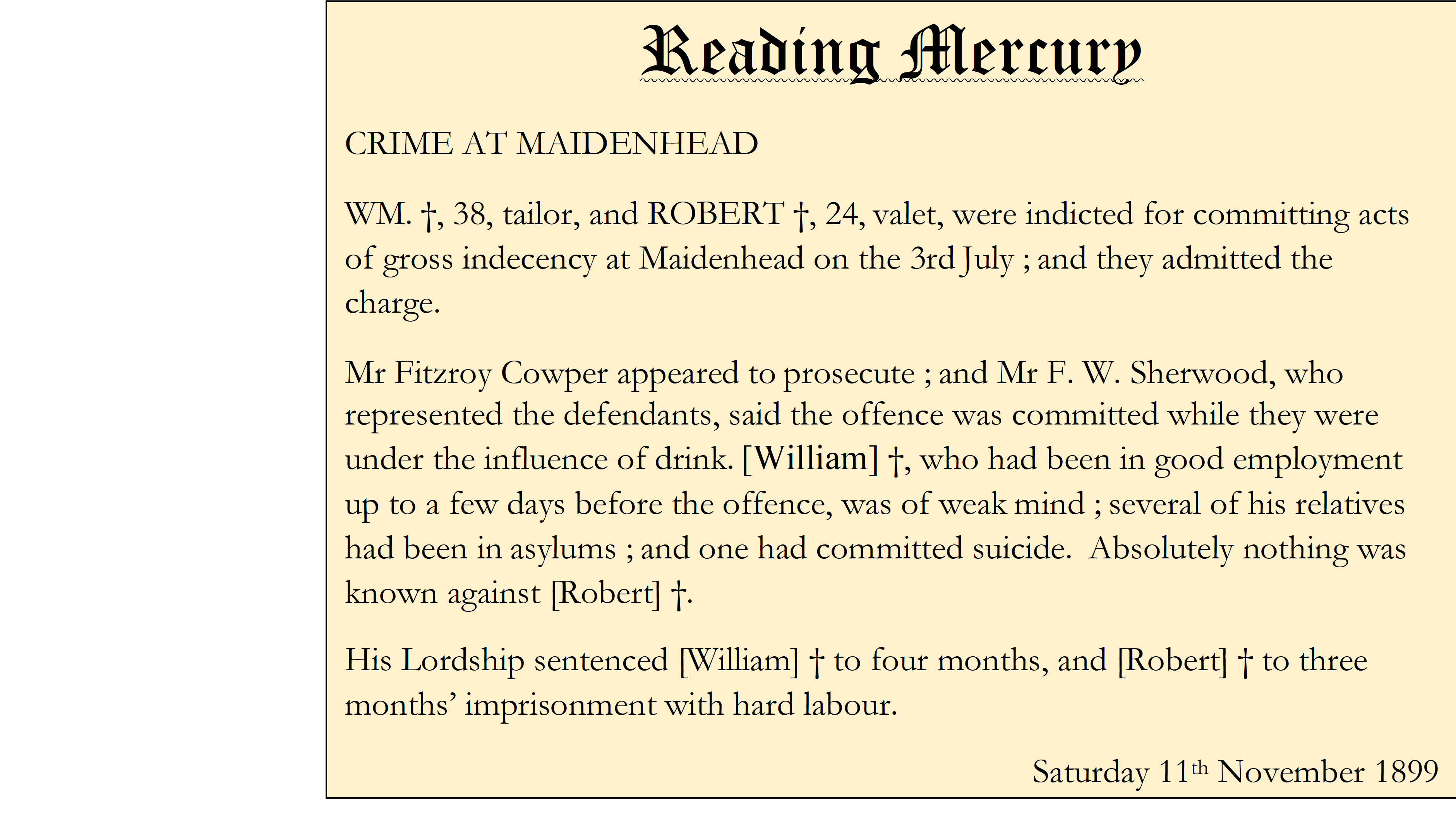
Gladstone was born on the 27th September 1885 in Galt, Ontario, Canada, to his mother Margaret and father, Henry, who went on to have four other children. In 1888, Gladstone’s father, Henry, was shot and murdered in his banking office by a client, who then shot himself upon leaving. Childcare was then left to Maggie, who in 1891 was living in the Waterloo South District of Galt with four of her children, including Gladstone, said to be age 4. It appears that Margaret, or Maggie, was a keen cook and a recipe she submitted in 1898 for ‘Pumpkin Marmalade’ still exists today and used by online bloggers researching the historical Cook Book.
In 1918, a long way away from Canada, Gladstone was located in the Berkshire Assizes Calendars of Prisoners with five counts of buggery, three counts of attempt to commit buggery and nine counts of gross indecency in respect of behaviour committed with five other persons, between the ages 15 to 17.
The Faringdon Advertiser and Vale of White Horse Gazette on Saturday June 29, 1918 provides a detailed account of the court proceedings:
– Audio credit: Mikhail Franklin
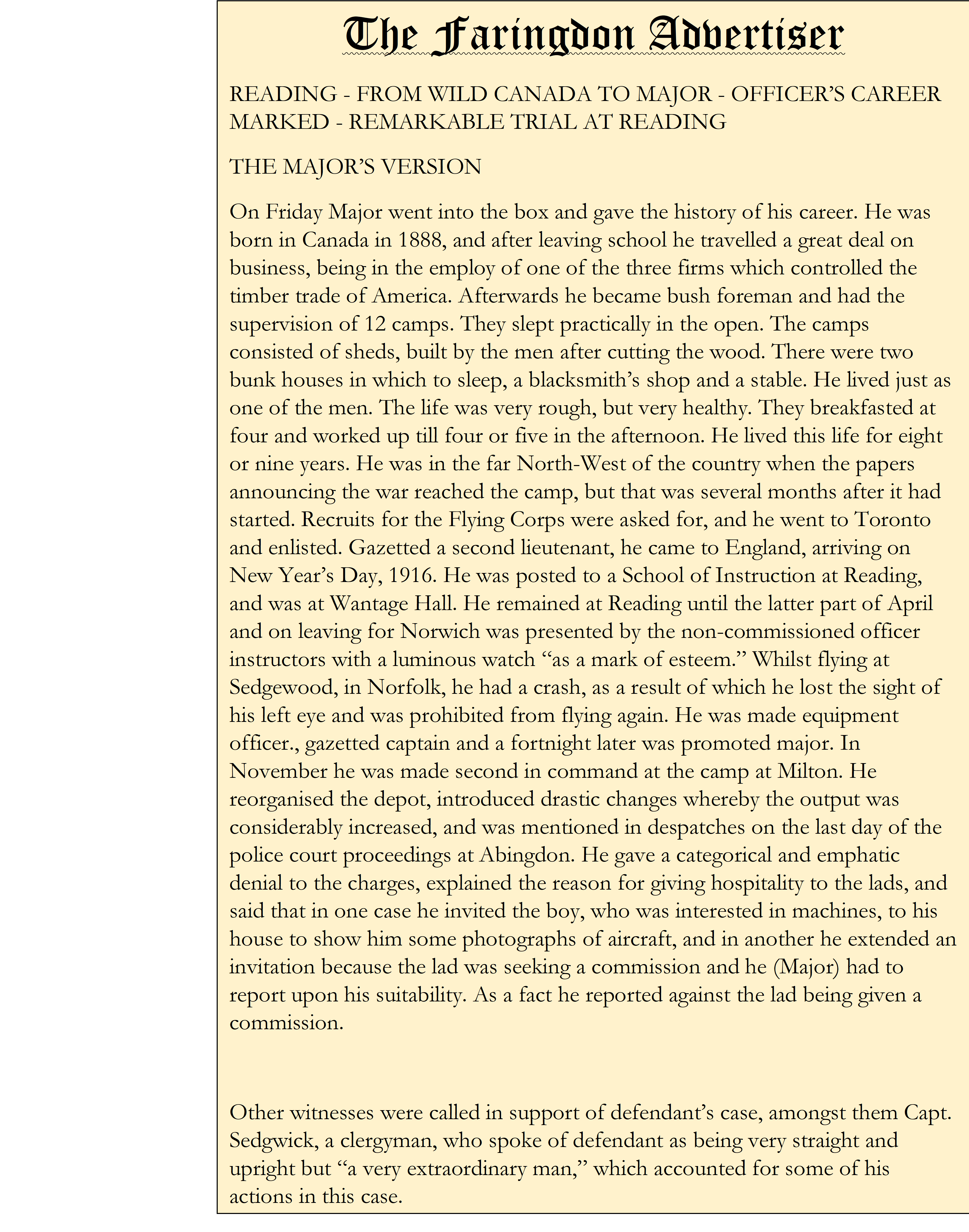
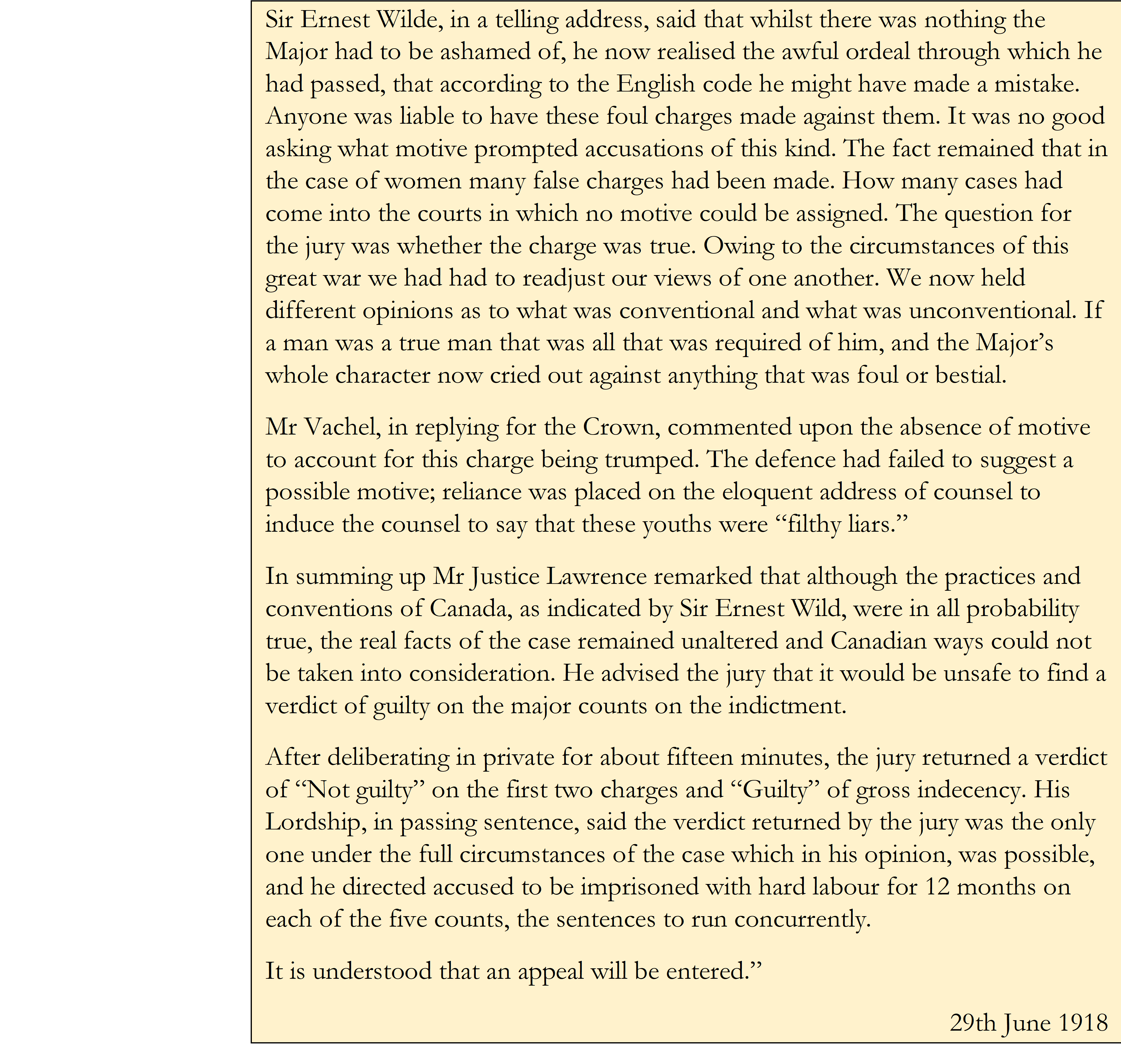
Gladstone’s prison records have not been located, but a travel document shows he left from Liverpool Docks destined for Montreal, Canada on 25th April 1919. Given his twelve month sentence, it appears he was released early from prison. It can be presumed that Gladstone left the UK immediately after his release. He arrived in Quebec on 18th May 1919 and he provided no occupation on the landing sheet. On 15th Feb 1920, Gladstone appears to have returned to Liverpool, giving his occupation as ‘author’ on this occasion but as ‘timber dealer’ on 16th March 1920. Unfortunately, we found no documentation on what he did while in the UK, but the shortness of the visit suggests that he needed to return for a particular reason.
Sadly, our research concluded with a death report of Gladstone having taken his own life on the 26th February 1932 with a 22 calibre rifle. We are unsure of the motivations for his actions and believe this is something that will never be uncovered.
Research into the HMP Reading Registers demonstrated that the Prison housed individuals with military convictions for ‘Disgraceful Conduct of an Indecent Kind’, ‘Indecent Conduct of a Disgraceful Kind’, or other variants of this term, with our first find in 1889.
William was one of those men, received into Reading Prison in 1893 after being court martialled in Malta and sentenced to two years’ imprisonment with hard labour, for ‘Indecent Conduct’. Further research on Fold3[1] located the Court Martial papers, charged alongside another William with the offence was recorded as… ‘indecent conduct in bed with a comrade’.[2]
Military men located in Reading Prison Registers have been harder to trace genealogically and within the newspapers, the latter as a result of the observation that the majority of military offences do not feature within any newspaper we can locate. After the location of the Fold3 file, it was clear that the two men were sent to different prisons, perhaps for obvious reasons. Further Records have been located that suggest the two William’s were both born fairly close to each other in Belfast, and that they may have both returned to the town after serving their sentence. There are also records that show that two men with the same full names as William and William were buried in the same place, Dundonald cemetery, Belfast; of course, it is impossible to know conclusively whether William and William every met after their sentence, or whether the fact they were buried in the same place was in fact a coincidence, or a matter of purpose.
[1] Fold3 brings together military records and history in one place. It is a paid subscription service and more information is available at: https://www.fold3.com/about
[2] UK, Courts Martial Registers, WO 86, Piece 043, Page 38, available online: https://www.fold3.com/image/537932322 accessed 24/03/2021
Cosmo was born in 1870 in the family home in Hertfordshire, the eighth of nine children. His family had aristocratic connections; his father was a major and a Justice of the Peace and was the grandson of an earl; his mother was the daughter of a duke.
Cosmo’s early life involved being educated away from home. At the age of 11, he was boarding at a school in Hastings, and his admission to Cambridge University shows that he also attended Monkton Combe School and Bedford College. There is no record of him graduating from Cambridge.
After university, he returned to his parents’ house, where he kept a room for the rest of his life. He spent time travelling abroad; records show him sailing to Madeira and returning first class from Marseille. At the time of the 1911 census, he was staying at the Hotel Metropole in Folkestone. In the census, Cosmo reports that he is married – we have never located any marriage records for Cosmo.
He lived on his own means, and was never employed. There are newspaper reports which show him receiving monetary gifts and annuities in the wills of several relatives, attending society weddings and funerals. In 1913, aged 43, he appeared in a local performance of Alice Through the Looking Glass in aid of the Church School Fund, in which he was, according to the local newspaper, a “particularly somnolent dormouse”.
In October 1914, at the beginning of the war, Cosmo, aged 44, enlisted as a private in the army, but he did not see any active service. His regimental conduct sheet shows that he was punished several times for being drunk in the canteen and for being absent during a tattoo. He was discharged after nine months, at the end of June 1915, for being ‘irregularly enlisted’.
His mother died in July 1915, leaving her effects to be shared between Cosmo and his oldest brother. The following year, 1916, saw Cosmo travelling again. This time, he was staying at the Ferry Hotel in Bourne End. On July 7th, he was arrested.
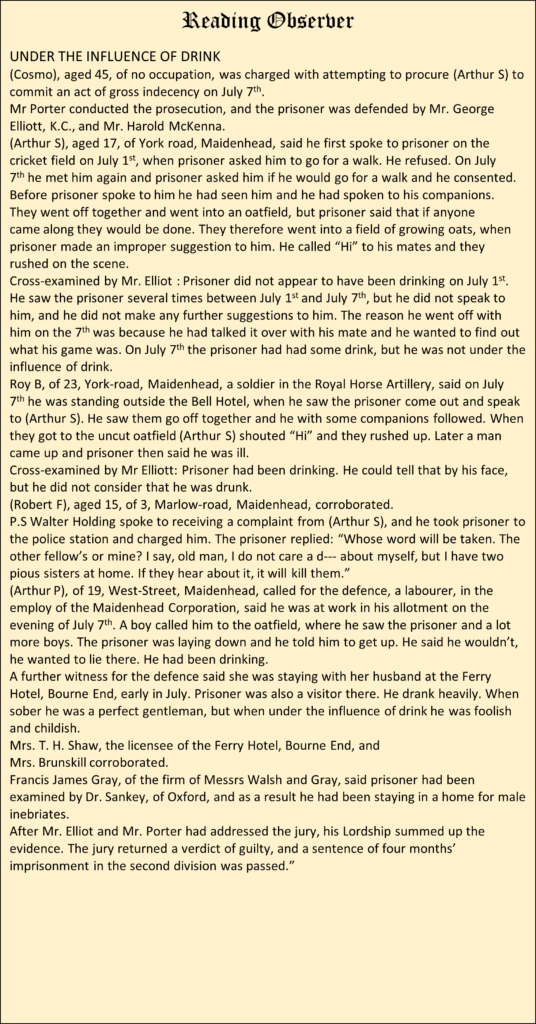
At his trial in October 1916, he was sentenced to four months’ imprisonment in the second division, which was a kind of superior prison experience: “Second division prisoners are kept apart, as far as possible, from other classes of prisoners. They receive more frequent letters and visits and they wear clothes of a different colour.”
Following his release, and after an illness lasting three months, he died from tuberculosis and a perforated intestine at the Nursing Home in Brighton on 20th May 1917, with his brother William beside him. In his will, Cosmo left nearly £6000 to be shared between his oldest brother and the youngest of his sisters.
—-
Credit for writing this biography goes to Vicki Ankerson, who was also responsible for in-depth research on a number of individuals. Thank you, Vicki!
John was born to an unmarried mother in 1888. After having another child, his mother married William L in 1890. William was a widower, who also had two children from a previous relationship. By 1901, there were another five children, and John and his sister had taken their father’s surname.
John L joined the army in 1908. He was 19 years old and over 6ft tall, which would have been unusually tall for the time. Perhaps for that reason, he joined the grenadier guards, who are the most senior infantry regiment in the British Army and generally comprise the tallest and strongest men.
At the time of the 1911 census, which was taken on 3 April, John’s family were still living in the country with 10 of their children. His mother was, by now, 46, and the record shows that she and William had a one month old daughter. John, meanwhile, was a private, stationed at Wellington Barracks in London, and had been awarded the Royal Victorian Medal (Bronze) in 1910. A part of the Royal Victorian Order, it is an award given personally for service to the Sovereign or the royal family.
On 20 July 1911, John was tried at a military court martial in Chelsea for ‘disgraceful conduct of an indecent kind’. His name appears in the Police Gazette on 8 August 1911 among deserters and absentees from His Majesty’s Service. He was sentenced to two years’ hard labour and discharged with ignominy, and he would have had to forfeit his medal and any accrued pension.
Following his imprisonment, John changed his name back to Smith and got married to Edith on 21 June 1913. He started work as an agricultural labourer and, in February of the following year, he and Edith had a daughter.
In 1915, however, Edith died and, a few months later, John (as John Smith) joined the army again, stating that he had never served before. This time, he became a private in the Royal West Surrey regiment, was promoted to Corporal in 1916 and fought in France with the British Expeditionary Force. Having received a gunshot wound in his left leg which resulted in its being amputated, he was discharged as physically unfit for service in 1917. He received an army pension of 8 shillings a week for the rest of his life.
After the war, John lived in London, and is shown in 1939 as a ‘government messenger’, living with his second wife, also called Edith.
He died in 1957, leaving his estate to his third wife Hilda and his daughter.
—
Credit for writing of this story goes to Vicki Ankerson, and for her valued and long-term contributions and support to the overall research and history group for the project.
